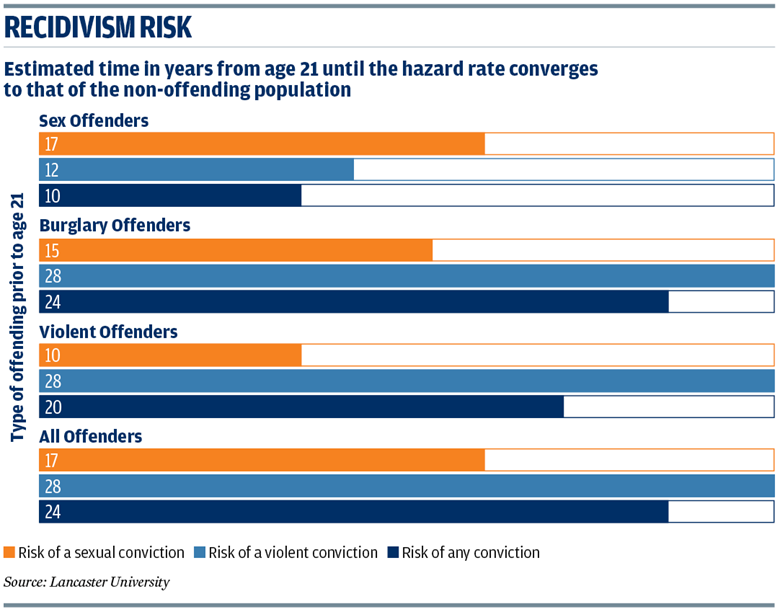Long-Term Recidivism Risk of Young Sexual Offenders in England and Wales
Charlotte Goddard
Tuesday, August 20, 2013
How the risks posed by juvenile sex offenders change over time.

Download at larger version of this graphic
Author: Claire Hargreaves and Brian Francis, Lancaster UniversityPublished by: Journal of Criminal Justice, June 2013
SUMMARY
This research aimed to find out whether juvenile sex offenders are more likely to go on to commit another sex offence than those who have not been previously convicted, and how the risks compare over time. It aimed to find out whether there comes a point where the risk of reoffending becomes so low that an offender theoretically poses no more of a risk to the public than the general population. It also examined whether there were differences between juvenile sex offenders, violent offenders and burglars in terms of their risk of going on to commit a sex offence.
The report, The Long-term Recidivism Risk of Young Sexual Offenders in England and Wales - Enduring Risk or Redemption? analysed data from the England and Wales Offenders Index. It looked at men who had committed a first sexual, violent or burglary offence below the age of 21. The sample of 920 sex offenders under 21 had a modal age of 17 when they committed their first offence. The authors tracked the offenders for up to 35 years. Some of the young people in the sample could not be tracked for the whole period, so some figures are approximations.
An estimated 23.5 per cent of sexual offenders were reconvicted of a crime after one year, with 6.5 per cent convicted of a violent offence and two per cent of a further sexual offence. Only 0.3 per cent of burglary and violent offenders committed a sexual crime a year after conviction.
After five years, seven per cent of juvenile sex offenders had been reconvicted of a sexual offence; after 35 years this rose to an estimated 13 per cent. Between two and three per cent of the other offending groups were convicted of a sexual offence after 35 years, while in the general population, rates were estimated at 0.8 per cent.
Juvenile sex offenders were also at risk of a subsequent violent conviction, with an estimated 32.8 per cent convicted of a violent offence over the 35-year period: this rate is slightly lower than the conviction rate for juvenile violent offenders (41.9 per cent) and burglary offenders (36.8 per cent) but substantially higher than for those who had not been previously convicted (5.5 per cent).
Young sexual offenders' risk of reoffending was found to rise steadily over 25 years and then flatten out. The risk of a sex offence reconviction decreased substantially from the age of 21, reaching a slower decline after 10 years when it stood at 0.2 per cent, just slightly above the violent and burglary groups, and those who have never been convicted.
According to the researchers' analysis, the risk - or "hazard rate" - of previously convicted sexual offenders reoffending and of previously unconvicted people committing a sexual offence become the same at the age of 38. In other words, they say, a young person convicted of a sexual offence before the age of 21, will by the age of 38 be no more likely to be convicted of another sexual offence than a general member of the public. So it takes 17 years for the hazard rate to converge with the rest of the non-offending population.
PRACTICE IMPLICATIONS
The authors say their research has implications for the registration period of juvenile sex offenders. While a registration system aims to protect the public, it can hinder the rehabilitation of the offender causing difficulties in finding housing or employment. They say the lengths of sexual offender registration periods have little or no empirical evidence to support them, and call for a review of registration after a conviction-free period, which would create a better balance between the protection of the public and the rights of the offender.
FURTHER READING
- Children Convicted of Sexual Offences: Do Lifelong Labels Really Help? Laura Janes, Howard Journal of Criminal Justice, May 2011. This article considers the legality of indefinite labelling for juvenile sex offenders and questions whether a lifelong register protects the public.
- Assessment and Treatment of Adolescent Sexual Offenders: Implications of Recent Research on Generalist Versus Specialist Explanations, Lesleigh Pullman and Michael Seto, Child Abuse & Neglect, March 2012. This paper identifies two kinds of adolescent sex offender and recommends that treatment be targeted accordingly.
- Children Who Display Harmful Sexual Behaviour: Assessing the Risks of Boys Abusing at Home, in the Community or Across Both Settings, Peter Yates, Stuart Allardyce, and Sarah MacQueen. Journal of Sexual Aggression, November 2011. This study found that abusive sexual behaviour progressed from the family into the community.




